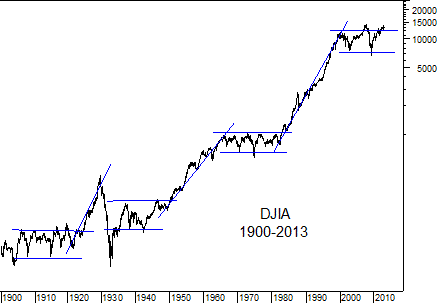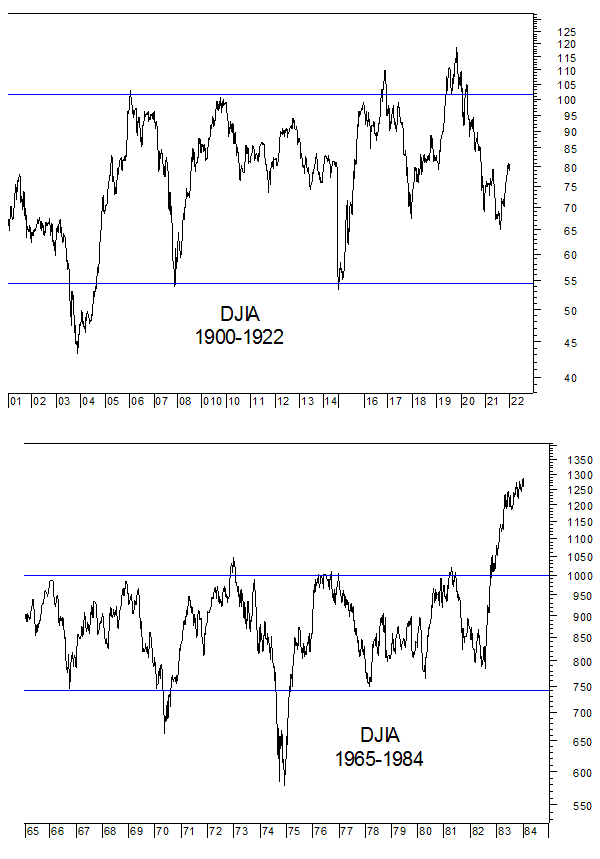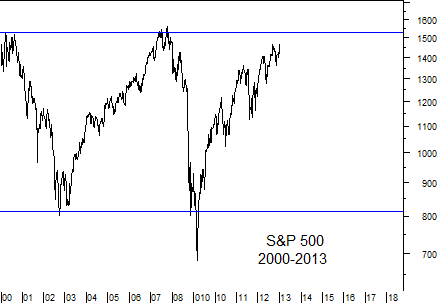Where Are We In the Stocks Secular Bear Market 2013?
Stock-Markets / Stocks Bear Market Jan 08, 2013 - 12:47 PM GMTBy: Sy_Harding
 It seems to only be when the market is in a cyclical bear market that the financial media remembers that a secular bear market began in 2000.
It seems to only be when the market is in a cyclical bear market that the financial media remembers that a secular bear market began in 2000.
That is completely forgotten once a cyclical bull market, like the one we’re currently enjoying, comes along within the secular bear.
As the market again approaches its previous peaks of 2000 and 2007 this might be a more helpful time to remember that we are in a secular bear market, which requires an entirely different approach to investing.
First a reminder that a secular bull market is a long-term uptrend. Cyclical bear markets take place within it, but when they end, the long-term uptrend resumes to ever higher highs. They are wonderful times for buy & hold investors, since the market always comes back and goes on to those ever higher highs.
A secular bear market is a long-term sideways to down trend, in which periodic cyclical bull markets take place that carry the market up to previous peaks, but then the next cyclical bear market arrives that takes the gains away. Obviously a disastrous time for buy & hold investing, and a great period for market-timing.
The last 110 years can be clearly divided into three completed secular bull markets, and three completed secular bear markets, with a fourth secular bear currently underway since 2000.

The secular bear market that began in 2000 continues to track similarly to the secular bear markets of 1900-21, and 1966-82.


Here’s what we’ve been reminding our subscribers of lately, as the favorable season continues and we remain on a buy signal.
So far, we’ve seen the 13-year secular bear that began in 2000 follow the same typical pattern of previous secular bears.
And we’re well aware of the surrounding conditions that have placed similar severe imbalances on the economy as in those previous periods; the 2000-2002 market collapse, terrorist attacks, Iraq and Afghanistan wars, easy money policies, etc., which allowed only a market recovery back to the 2000 peak in 2007, when the housing bubble burst and led to the near total financial system collapse in 2008.
As in the 1970’s, it is taking unusual stimulus measures, record budget deficits and debt loads, to recover from the disastrous decade.
And though each step has resulted in slow recovery, it will take at least one more setback for the economy and market (probably caused by austerity measures to tackle the debt problem), before the secular bear ends.
We need to be aware of that as we continue to navigate the cyclical bull market within the secular bear market.
As in the 1970’s, the next cyclical bear is not likely to be as severe as the last two, and it will likely finally end the secular bear market, and usher in the next secular bull market.
And that next secular bull market will result in the Dow eventually reaching 50,000 and beyond, that many were predicting in 1999 was just ahead, (while in my 1999 book Riding the Bear – How to Prosper in the Coming Bear Market I was predicting that the worst bear market since the 1929 crash was right around the corner).
How can we be sure that once this secular bear ends and the next secular bull market begins the Dow will soar to 50,000 and above? Because in each of the secular bull markets of the last 110 years, the Dow has gained 500% to 1000%.
The problem for investors will be the number who have not handled the secular bear market well, have sworn off the market for good, are no longer paying attention, and will not be enticed to participate again until the next secular bull market has been underway for years and the easiest money has already been made. That is the history of investor behavior in the previous secular bear markets.
Sy Harding was just named by Timer Digest as #1 Gold Timer for 2012 (Gold Timer of the Year), and #2 Long-Term Stock Market Timer for 2012.
Sy Harding is president of Asset Management Research Corp., and editor of the free market blog Street Smart Post.
© 2013 Copyright Sy Harding- All Rights Reserved
Disclaimer: The above is a matter of opinion provided for general information purposes only and is not intended as investment advice. Information and analysis above are derived from sources and utilising methods believed to be reliable, but we cannot accept responsibility for any losses you may incur as a result of this analysis. Individuals should consult with their personal financial advisors.
Sy Harding Archive |
© 2005-2022 http://www.MarketOracle.co.uk - The Market Oracle is a FREE Daily Financial Markets Analysis & Forecasting online publication.



